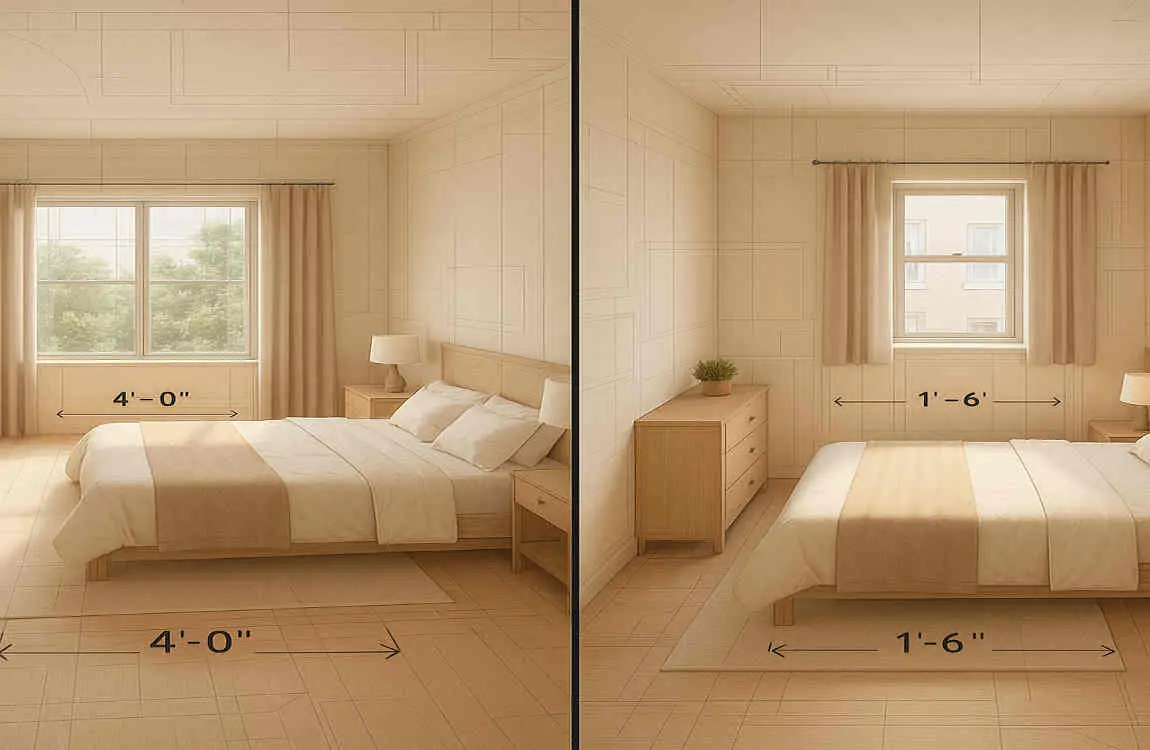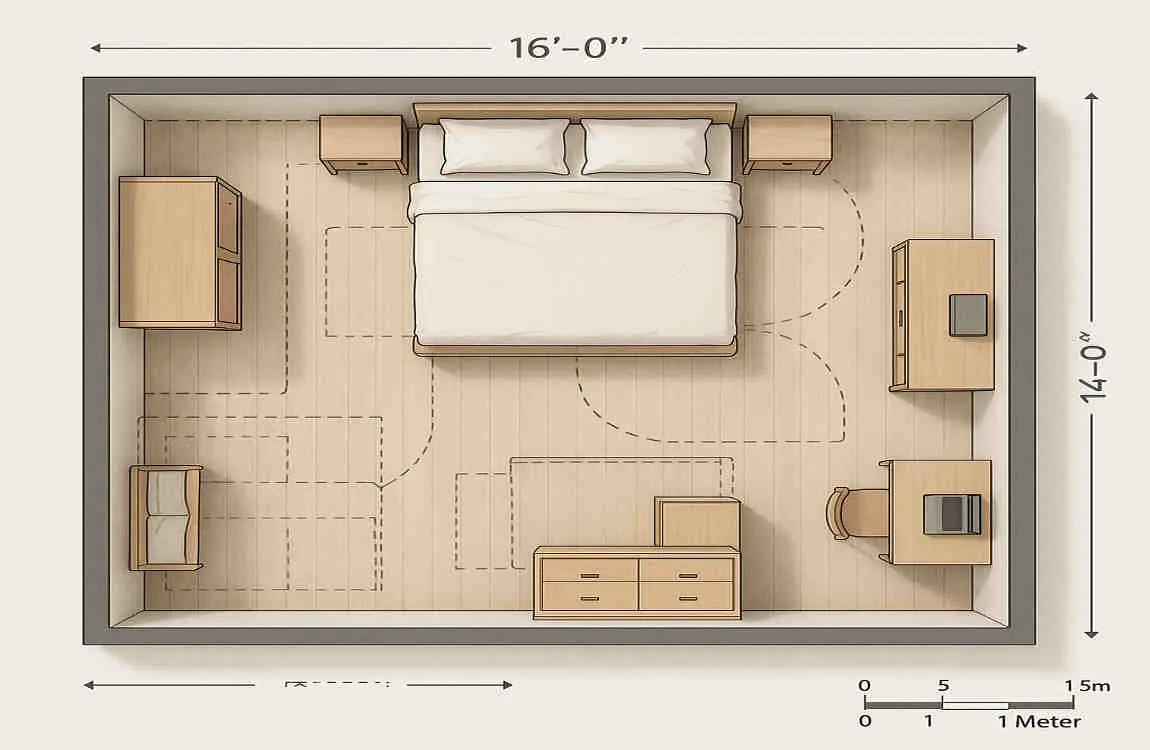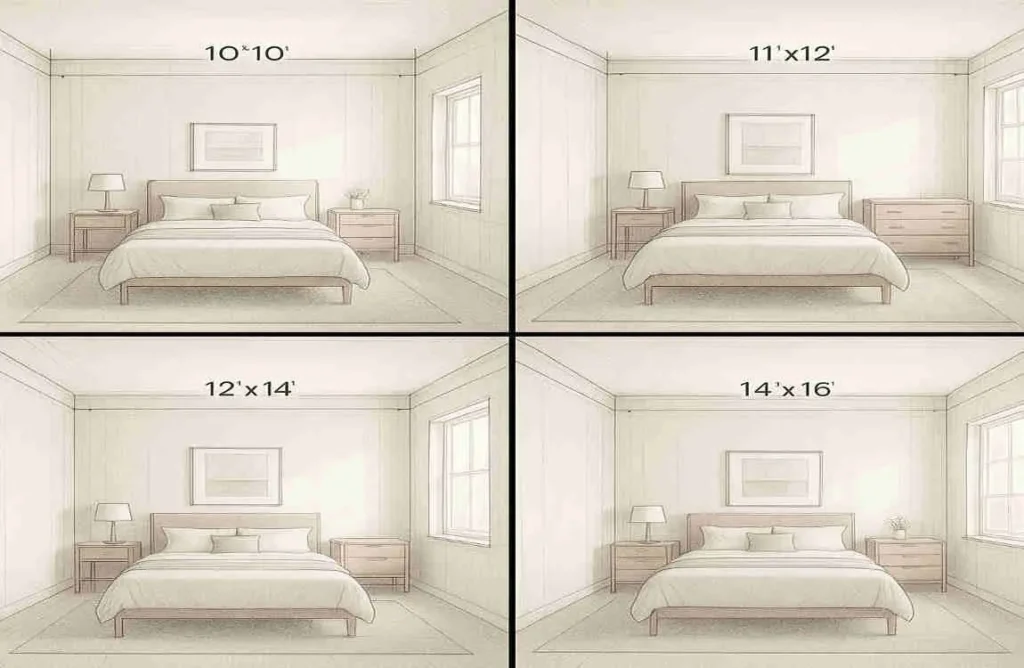Imagine walking into a bedroom that feels just right—not too cramped, not overwhelmingly vast. It’s that perfect space where you can unwind, sleep soundly, and maybe even sneak in a quick workout. The size of the bedroom plays a massive, significant role in how we experience our homes, and it’s something every homeowner, buyer, or builder should consider. But here’s the big question on everyone’s mind: what is the average size of a bedroom?
Understanding Bedroom Size Basics

Bedroom size might seem straightforward, but there’s more to it than meets the eye. Let’s break it down so you can picture it clearly.
What Bedroom Size Really Means
When we talk about bedroom size, we’re usually referring to the total square footage—the area of the floor space. You calculate it by multiplying the length by the width. For example, a room that’s 10 feet long and 12 feet wide gives you 120 square feet. But dimensions matter too; they tell you if a king-size bed will fit without bumping into walls.
Think about your own bedroom right now. Is it spacious enough for easy movement? That’s the essence of size—it’s about usability, not just numbers. Homeowners often overlook this until they’re trying to squeeze in furniture or feeling claustrophobic.
Types of Bedrooms and Their Purposes
Not all modern bedrooms are created equal. A main bedroom is typically the largest, designed for the main occupants, with ample space for a large bed, a closet, and possibly a sitting area. Guest bedrooms are more modest, intended for short stays, while kids’ rooms require space for play and growth.
Then there are bonus rooms, like a home office that doubles as a bedroom. Each type serves a different need, so their sizes vary. As someone in real estate, I’ve advised clients to prioritise versatile rooms that can adapt as their lives change when buying a family home.
Measurement Units in Home Design
In the US, we primarily use feet and square feet, whereas metric units, such as meters and square meters, are more common elsewhere. A standard US bedroom is 10×12 feet (120 sq ft), while in Europe, it’s 3×3.7 meters (about 11 sq m).
Why does this matter to you? If you’re shopping for homes internationally or using global decor ideas from sites like homeimprovementcast.co.uk, understanding both systems prevents mix-ups. Always convert if needed—there are free online tools for that.
What is the Average Size of a Bedroom?
So, let’s get to the heart of it: what is the average size of a bedroom? Based on real estate data and building standards, averages tend to hover around specific numbers; however, these figures shift depending on the location and type of home. I’ll share specifics to help you benchmark your space.
Average Sizes in the US and Globally
In the United States, the average bedroom size is about 132 square feet, according to the National Association of Home Builders. That’s roughly 11×12 feet. Master bedrooms often range from 200 to 300 square feet for a luxurious feel.
Globally, things differ. In the UK, averages are smaller at around 100-120 square feet (9-11 square meters), reflecting denser urban living. In Australia, you might see 120-150 square feet. These numbers come from housing surveys—consider how your region’s climate or culture may influence this. Warmer areas may favour larger rooms for improved airflow.
Ranges for Different Bedroom Types
Master bedrooms typically range from 200 to 400 square feet, giving space for en-suite bathrooms and walk-in closets. They’re the showstoppers in a home.
Standard secondary bedrooms? Aim for 100-150 square feet (10×10 to 12×12 feet). These are perfect for singles or couples who don’t need extras.
Small bedrooms or bonus rooms typically range from 70 to 100 square feet. They’re cosy for kids or offices, but can feel tight. I’ve shown homes where a tiny room turned buyers off—size really does impact appeal.
Variations by Home Size, Region, and Style
In a sprawling suburban house, bedrooms might average 150 square feet, while city apartments squeeze them to 90. Regional styles also play a role: Midwest farmhouse styles tend to be larger, while coastal modern homes prioritise efficiency.
Style-wise, colonial homes often have symmetrical, mid-sized rooms, whereas tiny homes shrink them to essentials. Ask yourself: Does your home’s style match your needs? If not, a remodel could help, drawing from decor tips on sites like homeimprovementcast.co.uk.
Factors Influencing Bedroom Size
The size of a bedroom isn’t random—several elements shape it. Understanding these concepts helps you plan more effectively, whether you’re building or buying.
Architectural Styles and Their Impact
Ranch-style homes typically house feature spacious bedrooms, often measuring 12×14 feet. Colonial designs stack rooms vertically, leading to compact 10×12 spaces. Modern minimalist homes? They emphasise open plans, sometimes blending bedrooms into loft spaces.
Farmhouse styles add charm with larger, rustic rooms. If you’re a fan of home decor, consider how style ties into size—a cosycosy farmhouse bedroom might feel perfect, even if it’s not huge.
Building Codes and Regulations
Local rules set minimums: In most US states, bedrooms need at least 70 square feet and 7 feet in one dimension for safety and egress. Some areas require windows for natural light.
These codes ensure livability, but their implementation varies. In Europe, minimum standards are similar but stricter regarding ventilation. Check your local regs before renovating—it’s a smart move to avoid costly fixes.
Other Key Influences
Several factors can tweak bedroom size:
- Number of Bedrooms: More rooms mean smaller sizes to fit the footprint.
- Budget and Land: Tight funds or small lots lead to compact designs.
- Lifestyle Needs: Do You Want a Home Gym? Add extra square footage.
As a real estate pro, I’ve seen buyers regret ignoring these. What about you? Consider your daily routine—does it demand more space?
Ideal Bedroom Sizes for Different Needs
Now that we know averages, let’s talk ideals. What’s “right” depends on who uses the room.
Space for Master Bedrooms
For ultimate comfort, aim for a main suite of 200-300 square feet. This fits a king bed, nightstands, and a reading nook. Add 50 more for an en-suite.
Functionality is key—ensure room for walking paths. If you’re coupling up, this size prevents feeling crowded.
Kids’ Bedrooms: Practical and Fun
Kids need 100-150 square feet to grow. It allows for toys, desks, and bunk beds without chaos.
Balance with storage; built-ins save space. As they age, the room can evolve—I’ve helped families redesign these for teens.
Guest Bedrooms and Multi-Purpose Rooms
Guests appreciate 100-120 square feet, which is enough for a queen bed and the basics. Keep it welcoming with neutral decor.
For multi-use? Flexible sizing (120+ square feet) allows it to transition seamlessly from office to nursery. Tips: Use Murphy beds or foldable furniture for versatility.
Impact of Bedroom Size on Home Value and Marketability
Size isn’t just about comfort—it’s money in the bank.
How Size Affects Pricing
Larger bedrooms can boost home value by 5-10%, according to real estate statistics. Buyers pay more for spacious master suites, seeing them as luxurious.
Small rooms? They can drag down appeal, especially in competitive markets. I’ve listed homes where adding an extra bedroom has increased the sale price by thousands of dollars.
Pros and Cons of Small vs. Large
Small bedrooms are easier to heat and clean, but they can feel limiting. Large ones offer flexibility, but they incur higher utility costs.
Trends favour balanced sizes—buyers want efficiency post-pandemic. What do you value more: cosiness or room to roam?
Current Market Trends
Today’s buyers typically seek spaces of 150 square feet or more for work-from-home setups. Eco-friendly homes prioritise smart sizing over excess.
Bedroom Size and Furniture Planning

Fitting house furniture right makes or breaks a room. Let’s plan smart.
Minimum Dimensions for Layouts
A twin bed requires at least 7×10 feet; a king requires 12×12 feet. Add 2-3 feet around for flow.
Wardrobes? 2 feet deep. Measure twice to avoid regrets.
Measuring Your Bedroom
Grab a tape measure and note length, width, height—factor in doors and windows.
Tips for Small Spaces
Utilise vertical storage and mirrors to enhance the space’s ambience. Multi-functional pieces shine here.
Furniture Type Minimum Room Size (sq ft)Ideal Dimensions (feet)Tips for Small Rooms
Twin Bed 70-90 7×10 Wall-mounted shelves to save floor space
Queen Bed 100-120 10×10 to 10×12 Under-bed storage drawers
King Bed 150-200 12×12 to 12×14 Slim nightstands; avoid bulky dressers
Dresser/Wardrobe Add 20-30 sq ft per piece N/A Choose tall, narrow designs
Bedroom Size in Different Home Types
Home type changes everything about size.
Apartments vs. Houses vs. Mobile Homes
Apartments average 80-100 square feet for efficiency. Houses cost $120-$ $150, while mobile homes cost $90-$120 due to their portability.
Tiny Homes and Compact Living
Tiny homes typically range from 50 to 80 square feet, often utilising lofts. It’s trendy for minimalists—maximise with clever decor.
Custom and Luxury Properties
Luxury pads boast 300+ square feet of master suites with spas. Custom builds tailored to you.
How to Calculate Bedroom Size Accurately
Don’t guess—measure properly.
Step-by-Step Guide
- Clear the room of obstacles.
- Measure wall-to-wall length and width.
- Multiply for square footage.
- Subtract built-ins if needed.
- Double-check with a laser tool.
Tools and Apps
Apps like RoomScan or MagicPlan make it fun and precise.
Common Mistakes
Ignoring irregular shapes or forgetting ceiling height—avoid these for accurate plans.
Bedroom Size Trends Over Time
Sizes have evolved—let’s look back and ahead.
Historical Shifts
In the 1950s, the average size was 100 square feet; now it’s 132, as families have increasingly sought more space.
Future Predictions
Expect multifunctional 150-square-foot rooms with smart tech. Remote work drives this.
Lifestyle Impacts
Post-COVID, bedrooms are doubling as offices, pushing up the size requirements.
Tips for Homeowners and Builders
Plan for success.
Planning in Construction
Consult professionals early and balance their input with the overall size of the home.
Balancing Sizes
Don’t oversize one room at the expense of another.
Maximising Small Bedrooms
Use light colours and multifunctional furniture—check homeimprovementcast.co.uk for decor ideas.
